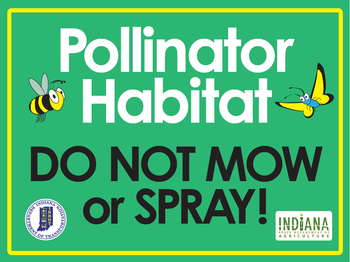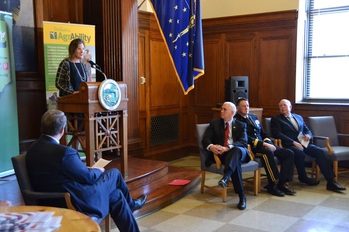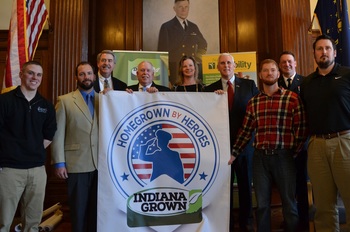 Letter from Lt. Governor Eric Holcomb
|
Dear friends in Indiana agriculture,
As you know better than most, Indiana’s agriculture industry has long represented an important economic catalyst for our state and a source of pride and identity for Hoosiers in every county. The work done by family farms has served as the backbone of the Indiana economy for 200 years, and agriculture operations small and large are driving the innovations that will define the industry in the 21st Century.
In fact, Indiana agriculture embodies many of the principles central to life here more than two centuries ago, when we were still the Indiana Territory. Those principles laid the foundation for the tremendous growth we are witnessing today in nearly all agriculture sectors. From livestock and poultry to crops of all kinds, from technology and data to agricultural equipment, food processing, Hoosier agriculture thrives because it is rooted in our most deeply held convictions.
That is why one of the most exciting aspects of my role as Lieutenant Governor is the opportunity it provides me to be Indiana’s Secretary of Agriculture. This has, for some time, been a topic of great interest to me. As I have traveled the state extensively over the years, I have come to develop a great appreciation for the manner in which strong Indiana farms contribute to the very high quality of life we, as Hoosiers, are so blessed to enjoy. Together with our experienced ISDA leadership and staff, it is a priority for me to do all I can to further strengthen this industry and be a resource for each individual farming operation upon which it is built.
This is a great time to be a part of agriculture here in Indiana. I love what I see. Together, we will continue to grow this industry for generations of farmers to come, and you can count on me to be your partner for the ride.
I eagerly look forward to working with everyone in Indiana agriculture as we plan for an even stronger future in the months and years ahead.
Sincerely,
 Lt. Governor Eric Holcomb
The President’s June 2014 call to action to create a strategy to promote the health of honey bees and other pollinators generated a great deal of "buzz" among state agencies, private sector businesses, nonprofit groups and communities across the country. The strategy called for a substantial increase in habitat acreage nationwide, working to reduce stress on pollinators, which continue to play a vital role in the production of food we consume each day.
In response to the call to action, the Office of the Indiana State Chemist and the Indiana Pesticide
Review Board, which are housed at Purdue University, began developing a Managed Pollinator Protection Plan (MP3) for the state. The key objectives of the plan include: (1) reducing pesticide exposure to bees and other pollinators through timely
communication and coordination among stakeholders and (2) increasing foraging, shelter, nesting, and brooding areas. More information on implementation and progress of that plan can be
found by clicking here.
In an effort to assist with pollinator habitat expansion statewide, ISDA met with a variety of stakeholders in three working groups over the summer to discuss issues such as habitat expansion, funding opportunities, best practices for promoting pollinator health as well as community outreach. The recommendation that came out of the working groups was for ISDA to aggregate resources and develop a web portal, which would serve as a focal point for information, highlighting the efforts of nonprofit groups, governmental organizations and communities on pollinator habitat expansion.

ISDA is proud to officially launch this new web portal which includes general information on pollinators, important tips on developing and maintaining a habitat and connects individuals with funding opportunities as well as additional resources. The site will further be used to draw attention to our Indiana Grown members who are beekeepers. Many of them do extraordinary work in this field by not only maintaining healthy pollinators, but also generating new business in Indiana.
Click here to view this new web portal!
Recently, ISDA and Indiana Grown announced a new partnership with Homegrown by Heroes, a national organization dedicated to providing resources, assistance and product identification to farmer-veterans. Essentially, the partnership allows
a veteran-owned Hoosier agricultural business to place a logo – specifically
designed for Indiana – on products they grow, sell or distribute. This will
help consumers more easily identify products that are not only grown in
Indiana, but also made by a veteran.
To kick-off the program, an announcement was made at the historic Indiana War Memorial. Alongside ISDA Director Ted McKinney, who served as the moderator, many distinguished guests attended the event including Governor Mike Pence, officials from the Indiana Department of Veteran Affairs, military personnel and members of the agricultural community.

However, one of the highlights of the event was the testimony given by Sara Creech, who is an Air Force veteran, owner of Blue Yonder Organic Farm and one of the first members of the Indiana Grown Homegrown By Heroes program. Sara spoke about the healing powers of farming, how it helped her transition from military to civilian life and how excited she was to be part of the program.
After she spoke, the logo was officially unveiled, which is a combination of the Homegrown by Heroes and the Indiana Grown logos, and was presented as a large banner to several farmer-veterans along with a special certificate, welcoming them into the program.

Since the announcement was made, many people have expressed interest into both organizations, and we are proud to have several new farmer-veterans join the Indiana Grown ranks as a result. Details regarding application requirements and members can be found at IndianaGrown.org.
In last month's Agriculture Insider, we provided a brief overview of important bills making their way through the Legislature: Senate Enrolled Act (SEA) 238 and SEA 308. Since the
Indiana General Assembly has now concluded its business for 2016, we wanted to provide a brief update on those particular pieces of legislation.
Senate Enrolled Act 238: Soil and Water Conservation Funding
The legislation eliminates a barrier for Soil and
Water Conservation Districts that decide to merge by increasing the matching
state grant based on the following situations: (1) If two county-wide districts
merge, the legislation allows the state match to be multiplied by the number
of counties merging and; (2) if part of a county merges with another district,
the bill allows the state match to be multiplied by the percentage of county
area included in the newly merged district. It passed the Senate 48-2. The bill
was amended in the House to allow cases, in which a district did not receive funding from a political
subdivision, to seek outside funding for the matching grant. This version passed the House 96-0, and the Senate
concurred with the change.This legislation has been signed into law by the Governor and will go into effect on July 1, 2016.
Senate Enrolled Act 308:
Farmland Property Taxes
This
bill makes adjustments to calculating the base rate for farmland taxes. When
calculating the base rate for agricultural land for the January 1, 2016,
assessment date and each assessment date thereafter, the department of local
government finance shall do the following: (1) Use the six most recent years
preceding the year in which the assessment date occurs for which data is
available (before the highest of those six years is eliminated when determining
the rolling average), (2) After determining a preliminary base rate that would
apply for the assessment date, adjust the preliminary base rate according to
certain criteria. This part gets a little complex but the capitalization rate
will fall somewhere between 6% and 8% depending on how the preliminary
assessment compares to the final assessment. Another notable point is that soil
productivity factors used for the March 1, 2011 assessment will be used for the
January 1, 2016 assessment and each assessment date thereafter. The conference
committee report was adopted by the House by vote of 84-12 and then by the
Senate by 44-6. This legislation has been signed into law by the Governor.
|